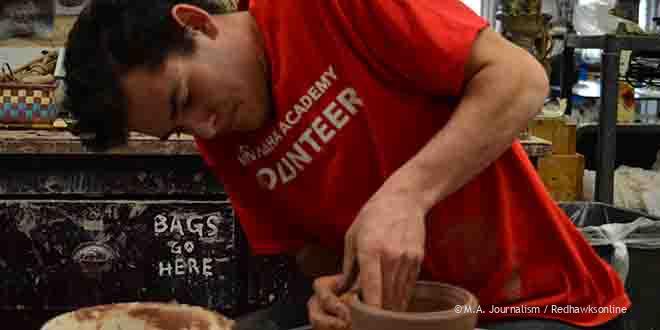STEAM education works to place emphasis on the arts as well as science
What is a new scientific discovery without a powerful speech to accompany it? What are new blueprints for a rocket without the mathematical calculations to send it into space?
Society cannot function with completely polarized paths of learning-such as science and humanities.
Instead, look between the lines.
Crafting a song through a formula of chords. Designing a model for a physics experiment. What do these activities have in common?
Science and the arts are both integrated in one, making a more cohesive and comprehensive blend of skills.
For a number of years, the resurgence of science, technology, engineering and math (STEM) programs have overshadowed many careers in the humanities or liberal arts across the country.
Instead of an intensifying divide between STEM and the humanities, the education world has crafted STEAM-programs targeting the integration of STEM, arts and the humanities.
“It is great that we can provide research and opportunities for the science and math spectrum,” CIS anatomy and physiology teacher Nancy Cripe said. “In some ways, in the United States, we’ve kind of slipped away from our strong mooring in science and math.”
In 2015, the United States reported 29 percent of 15-year-olds to perform below level two in mathematical literacy and only six percent above level five, compared to the most “healthy” country of Singapore, with only eight percent below level two and 35 percent above level five, according to the National Center for Education Statistics, the 2015 Program for International Student Assessment tests in mathematical literacy.
While STEM programs are providing a way to rebuild the country’s lost ground, the humanities and arts, however, cannot be forgotten along the way.
“As humans who are thinking, being, wondering and struggling, we continue to seek for how to live and interact,” English teacher Katherine Myers said.
“Humanities sweep us along that path. Just a simple piece of art can inspire and illuminate, with music it is the same. I think us without literature, poetry and art, we run dry. It reminds us how to be human.”
Regardless of whether or not a student feels as if they are heading down one pathway, it is important to keep all the options open.
No one expects a student to know exactly what they want to practice further in life or stick to one idea of a path to take.
In fact, the south campus practices integrated learning of the arts and sciences as early as in kindergarten.
“There’s a great visual that has many paint buckets with different colors that are nice and neat,” lower and middle school principal Karen Balmer said.
“Sometimes that’s how school looks. Life, however, is a palette of colors, mixed up and it’s beautiful. That’s the beauty of integrated, interdisciplinary learning.”
It is no secret that the science department, however, has literally expanded itself on the front lawn in the form of a new STEM lab. Interesting opportunities such as the International Space Station program and new applied research and engineering classes definitely created a shift among some of the student body.
However, this is not to say that the administration has forgotten about the humanities.
The lack of new opportunities in the English and social studies departments, for example, are a result of low enrollment.
“As a school, it is not our job to dictate what paths people need to go down,” upper school principal Jason Wenschlag said.
“I feel like we need to offer liberal arts programs, philosophically. Practically speaking, if three kids register for creative writing, it is difficult to run those courses in most schools. But, that’s why we have clubs. If there is a need for a creative writing outlet, you’ll see clubs with students that drive it.”
Fortunately, fears of increasing polarization of the arts and sciences can be addressed.
STEM and the arts can come together in the form of STEAM focused activities.
Senior Ole Roof has maintained a rigorous schedule in both the arts and sciences, creating a STEAM world of his own.
Roof is involved with the jazz band, symphonic wind ensemble and concert band, all the while taking every AP level math and science course offered.
“I can learn so much from each side,” Roof said. “With STEM, you learn the analytical thinking skills. But, with band and the arts, you learn creative thinking. It is also very important moving forward if I ever get a job that involves engineering. You need to have creative thinking skills, especially if you’re in innovation.”
While innovation in engineering is one option of a STEAM fueled career choice, integrating the arts and sciences in daily life may be more obvious than one may think.
“I have never thought that [STEM and the humanities] couldn’t be linked,” Myers said. “If STEM is about a scientific discovery, creating or inventing, how does one then want to show the world? Through a speech? A book? Some of the greatest scientists are the best writers and the best thinkers. There are nuclear physicists that have become impassioned writers and poets. Those cannot be mutually exclusive worlds. It is an absolute pity if that’s been a message.”

